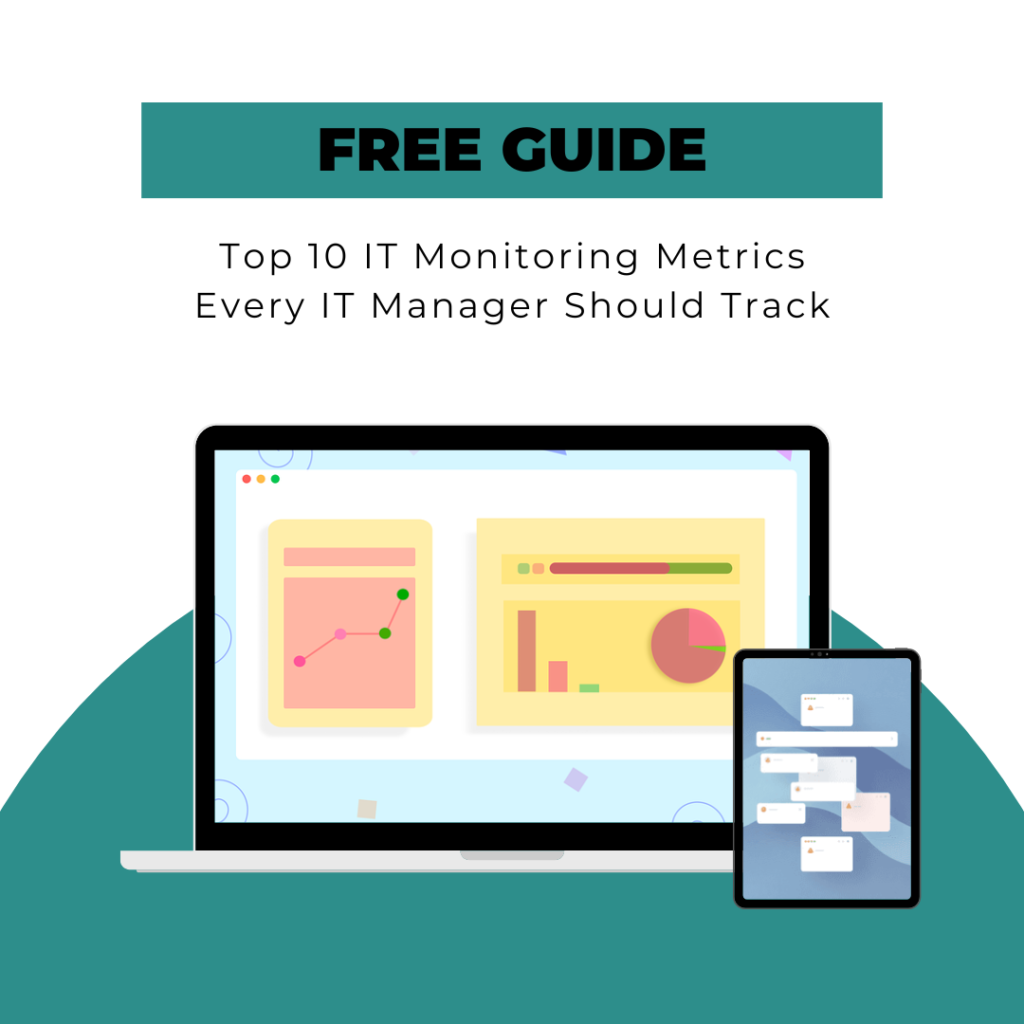Common IT Infrastructure Challenges in Managing IT Infrastructure
Here are some typical challenges organizations face when managing their IT setup:
- System Complexity: Dealing with a mix of cloud services and older systems
- Security Threats: Protecting against constantly changing cybersecurity risks and weaknesses
- Resource Constraints: Finding a balance between improving performance and limited resources
- Alert Fatigue: Telling apart serious issues from regular alerts to avoid feeling overwhelmed
This guide offers a 30-day plan to help you improve your IT monitoring and management. You’ll discover practical ways to:
- Set up proactive monitoring methods
- Create effective incident monitoring and response plans
- Enhance your infrastructure’s performance through targeted monitoring improvements
- Track KPIs for better monitoring insights
A comprehensive approach to IT monitoring and management brings clear benefits to your organization:
- 99.9% system uptime through continuous monitoring
- Faster incident resolution times with real-time monitoring
- Increased operational efficiency through automated monitoring
- Stronger business continuity planning with preventive monitoring
- Better resource allocation through performance monitoring
By using these proven monitoring strategies, you’ll create an IT infrastructure that can tackle challenges like system complexity, support your business goals, and minimize costly disruptions while effectively tracking API usage and performance. Also, look for ways to improve application performance with monitoring tools that match your key performance indicators (KPIs).
Understanding IT Downtime and Its Effects on Business Operations
IT downtime refers to the unavailability of systems or services, which can seriously affect business operations by reducing productivity, revenue, and data integrity.
- Planned Downtime: This happens when systems are intentionally taken offline for maintenance or upgrades.
- Unplanned Downtime: This includes unexpected interruptions in services due to hardware failures, software problems, or outside factors.
Business Consequences:
- Financial loss (avg. $300K/hour; up to $540K/hour)
- Lower employee productivity
- Missed SLAs
- Brand damage and loss of customer trust
- Supply chain disruptions
Industry Insights according to Uptime Institute’s 2023 report:
- 80% of data centers had outages in the past 3 years ()
- 20% experienced serious outages
- 60% of major outages caused over $100K in losses
Why It Matters:
Understanding and preparing for both types of downtime helps companies:
- Detect issues early through performance monitoring
- Minimize financial and operational risk
- Maintain business continuity and customer confidence
1. Key Performance Indicators (KPIs) for Better IT Visibility
To manage IT systems well, it’s important to track certain key performance indicators (KPIs). These metrics act as early warnings, helping teams identify and fix issues before they cause major problems.
Importance of Monitoring KPIs
Keeping an eye on metrics like system uptime and response times is vital for smooth operations. Also, monitoring how resources are used ensures everything is running efficiently, while real-time alerts can quickly inform teams about any unusual activity.
Benefits of Focusing on KPIs
By concentrating on these KPIs, organizations can keep their IT systems strong and avoid disruptions that could hurt productivity. Taking a proactive approach to monitoring these indicators helps catch potential issues early, protecting the overall health of IT operations.
Important Metrics for Infrastructure Health:
1. Tracking System Uptime
Aim for 99.99% uptime, measured over different time frames and by each service or component. Use monitoring tools to understand uptime trends.
2. Monitoring Response Times
Keep track of network delays, how fast applications respond, database query speeds, and API response times. Grafana can help visualize this data for better analysis.
3. Tracking Resource Usage
Watch CPU usage, memory use, storage trends, and network bandwidth. Zabbix can effectively monitor these important metrics.
Real-time alerts make these metrics useful. By setting clear limits for each metric, you can receive automatic notifications when systems go out of the normal range. This helps quickly spot issues and speeds up response times. Use API integration with monitoring tools to improve your alerting process.
🔍 Want to Improve Your IT Monitoring Skills?
Download Our Free Guide: “Top 10 IT Monitoring Metrics Every IT Manager Should Track“
✅ Easy explanations of essential metrics
✅ Ready-to-use monitoring templates
✅ Expert tips for implementation
✅ Real-world examples
Don’t Wait for Your Next Outage! 👉 Get Your Free Guide Now and Upgrade Your IT Monitoring Strategy Today!

2. Proactive Monitoring Strategies to Prevent Outages Before They Happen
Waiting for problems to happen in IT management leads to constant crises, wasting resources and disrupting business operations. Using proactive monitoring strategies helps identify and fix potential issues before they become major system failures. This approach is crucial for optimizing infrastructure effectively.
Key Benefits of Proactive Monitoring:
- 60% less unexpected downtime
- Better use of resources
- Lower operational costs
- Increased team productivity
- More reliable systems through improved reliability techniques
Modern automated monitoring tools give a complete view of your IT setup. Tools like Zabbix provide:
- Real-time performance data to improve system performance
- Automatic health checks
- Predictive analytics
- Custom alert settings
- Ability to connect with existing systems in a cloud-based environment
By using these proactive monitoring strategies, organizations can greatly reduce the risk of IT outages and ensure their infrastructure runs efficiently.
Recommended Monitoring Tools:
1. Grafana
Grafana is a powerful tool for IT monitoring that lets you create custom dashboards to display data from different sources. You can also set up alerts easily.
2. Zabbix
Zabbix is great for quickly spotting and analyzing incidents. It automatically detects devices and monitors them from various locations, using templates for easy setup. With its smart incident detection and detailed alert analysis, Zabbix is crucial for managing IT crises effectively.
These automated monitoring tools come with strong APIs to connect with your existing IT service management tools, making it easier to keep an eye on everything in your infrastructure. You might also want to look into integrating features from SolarWinds or Nagios to improve your monitoring processes and prioritize issues automatically.
3. Ways to Improve Infrastructure for Better Performance and Reliability
To improve your infrastructure effectively, you need a balanced approach that enhances system performance and ensures reliability. Here are some key strategies to strengthen your infrastructure:
- Use load balancing techniques to evenly distribute server workloads. This helps manage traffic based on performance, allowing your systems to handle different loads efficiently.
- Consider distributing loads based on location to make the best use of resources in various areas. This not only speeds up response times but also keeps sessions consistent in applications.
- Regularly check your infrastructure to find bottlenecks and evaluate overall performance. Spotting these issues can help you tackle problems, keeping operations running smoothly and reliably.
By taking these steps, you can make sure your network runs smoothly, reduce delays, and keep essential business operations going. Also, doing a thorough Network Assessment can improve your monitoring efforts and help you find areas for improvement.
🎯 Need a Clearer View of Your Network?
Kibalto specializes in network assessments that uncover blind spots and help IT leaders optimize performance and reduce costs.
Book a FREE 30-minute consultation with one of us and get a personalized estimate for your Network Assessment.
- Talk to an infrastructure expert
- No obligation
- Tailored to your environment
- Actionable insights from day one

4. Incident Response Planning: Reducing Downtime with Smart Strategies and Automation Tools
Having a good incident response plan is essential for your organization to handle system failures effectively. A solid plan helps you deal with major disruptions smoothly. Here’s how to create and automate an effective incident response strategy using automated techniques and management tools:
- Define Clear Roles and Responsibilities: Make sure everyone knows their duties during an incident. Clarifying roles is key for good teamwork.
- Establish Communication Protocols: Set up clear ways to share updates and alerts. Good communication during incidents can greatly speed up response times.
- Integrate Metric Collection: Use dashboards to keep track of important performance indicators (KPIs) during incidents. Collecting metrics is an important part of your strategy.
- Implement Observability Practices: Ensure your systems provide real-time data for better decision-making. Using observability practices will help you react quickly.
- Utilize Managed Metrics Collection Services: Simplify data gathering so you can focus on responding. These services allow for continuous monitoring, freeing up resources for critical tasks.

By including these elements, you can build a strong incident response plan that reduces downtime and improves overall resilience.
Key Parts of an Incident Response Plan:
A strong incident response plan helps teams manage disruptions efficiently and minimize downtime. Key components include:
1. Incident Classification Matrix
- Uses severity levels (P1–P4) to assess impact and assign appropriate response.
- Defines response times based on urgency.
2. Response Team Structure
- Clearly assigned roles and escalation procedures.
- Emphasizes stakeholder communication during incidents.
3. Automated Response Workflows
- Pre-approved scripts and self-repair features reduce manual work and downtime.
- Rollback mechanisms ensure safety when reversing changes.
4. Monitoring
- Real-time monitoring helps detect incidents early and assess severity using the matrix.
Monitoring + Ticketing System Integration
- Automates ticket creation based on alert level
- Routes incidents to the right teams
- Shares real-time updates and documents events automatically
- Uses API and uptime monitoring for seamless integration
These strategies not only enhance efficiency but also help teams respond quickly to incidents while keeping high standards of quality and accuracy.
Creating a Strong Monitoring Strategy That Matches Company Goals
A good monitoring strategy should connect technical skills with business goals. This approach, focused on aligning monitoring strategies with business objectives, includes several key elements:

Key Parts of the Strategy:
- Choosing KPIs that match business goals
- Setting custom alert levels
- Planning resource allocation
- Creating communication plans for stakeholders
- Identifying integration needs
- Considering future growth
During the design phase, it’s important to focus on the specific needs of different departments. For example, a manufacturing company might look at production metrics, while a financial institution focuses on transaction speeds and security.
Custom Dashboard Development:
- Executive dashboards that show overall business impact
- Technical dashboards for IT troubleshooting
- Department-specific views for targeted monitoring
- Real-time status boards for operations teams
Custom dashboard development turns raw data into valuable insights. Each view should cater to the specific needs of its users, whether they are executives tracking business metrics or IT staff checking system health.
Integration Architecture:
- Network monitoring tools
- Cloud service metrics
- Security information systems
- Application performance data
- Infrastructure health indicators
A strong strategy combines data from various sources into one monitoring system. This integration architecture gives a complete view across the IT landscape while keeping specific areas in focus for different groups.
The implementation should include regular reviews and updates based on changing business needs and technology advancements. This flexible approach ensures the monitoring system continues to provide value as companies grow and change.
Conclusion: Take Charge of Your IT Infrastructure Today!
Building a solid IT infrastructure means making strong decisions. Your organization’s success relies on effective strategies to manage your IT, like the ones outlined in this guide:
- Set up proactive alert systems
- Create an incident response plan
- Develop custom performance dashboards
These actions need careful planning and resource management in your IT setup. However, the rewards of reduced downtime and improved system stability are crucial for businesses today.
🎯 Ready to enhance your IT infrastructure?
Kibalto provides real-time monitoring, proactive support, and cost-effective cloud solutions to keep your systems secure and scalable. We specialize in network security, real-time IT monitoring, and proactive infrastructure management.
Don’t let system failures disrupt your business. Take charge of your IT infrastructure and secure your organization’s digital future.



